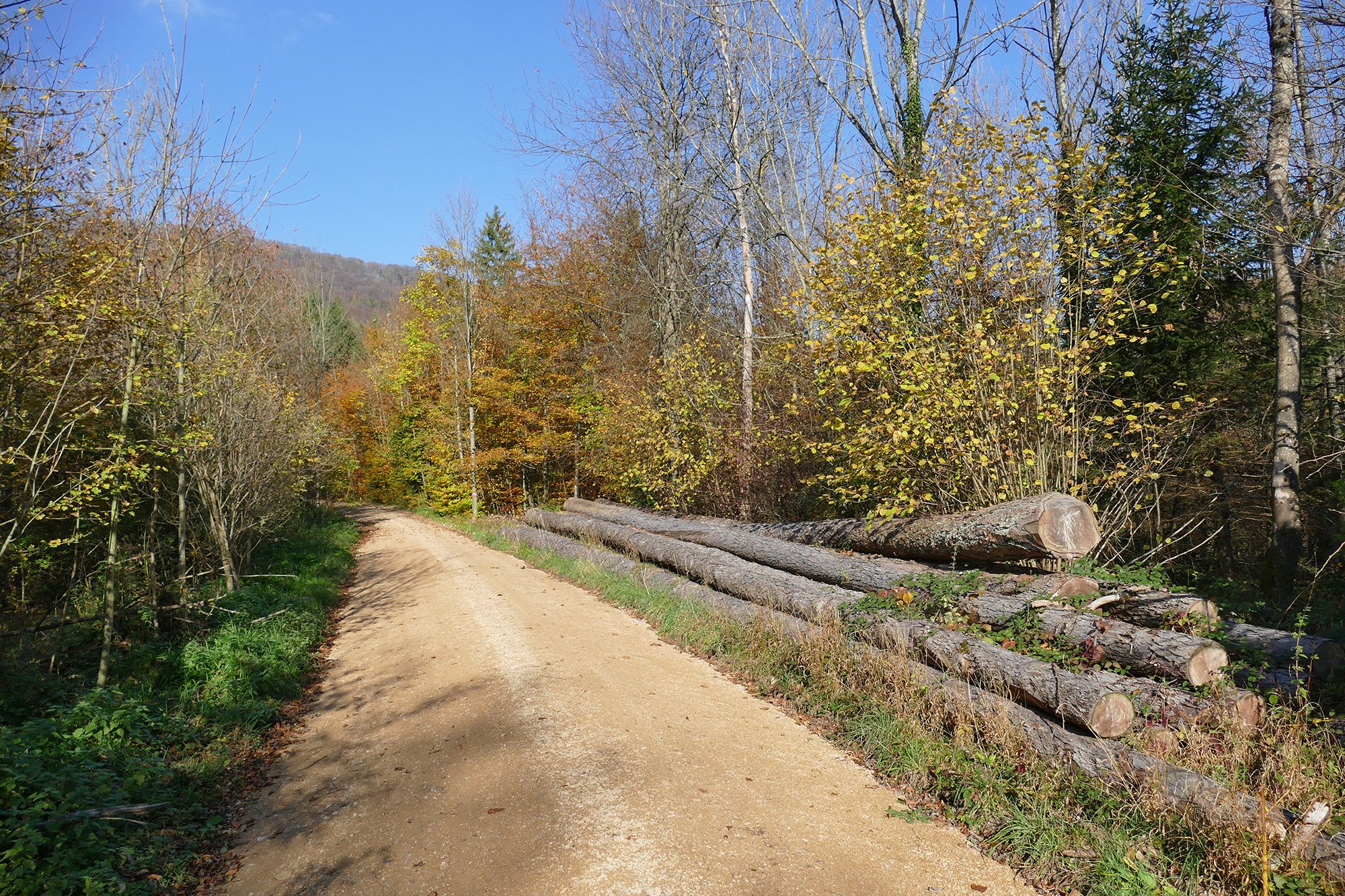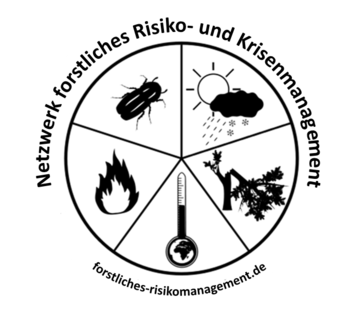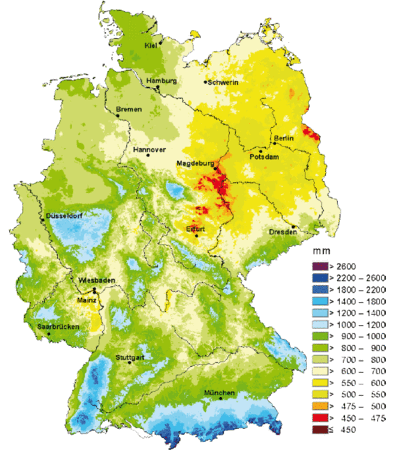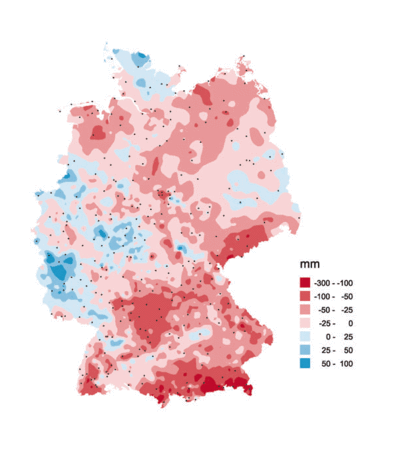An average total annual precipitation of over 500 mm is in Central Europe a prerequisite so that closed forests can grow. In mountainous areas, the timber line depends among others thing on the water scarcity during the long dormancy period and above all on frost drought. The precipitation map of Germany (Fig. 1) clearly shows where there is drought problem today. Brandenburg, Mecklenburg-Vorpommern and parts of Lower Saxony are characterized by particularly low precipitation values. In light of climate change, the situation could worsen in some forest areas.
Water scarcity due to climate change
The IPCC (Intergovernmental Panel on Climate Change) has developed different scenarios for the global climatic development up until 2050 and 2100. Figure 2 shows that by 2050 an overwhelmingly large area of Germany will be affected by a significant decline in annual precipitation. In some cases, this might mean up to 300 mm less precipitation per year. Significant increases of up to 100 mm could be found in some parts of northern and western Germany. Overall, the precipitation will rather shift to the winter months, while the growing season will face increasing drought. According to an expert survey, drought represents the most important effect of climate change on forest growth.
Water shortage and its effects
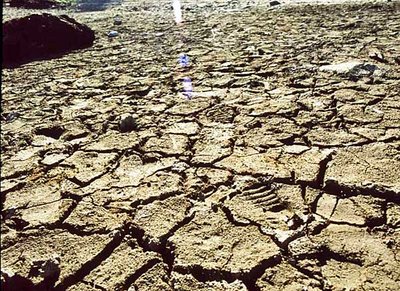
Fig. 3: Dry soil. (Photo: Photo database ForstBW)
There is a fundamental difference between acute and chronic water shortage. Acute water shortage occurs regularly in Central Europe in the spring. This affects above all the regeneration and is considered as a trigger for complex diseases such as dying of fir and oak trees.
Chronic water shortage is regarded as being the characteristic of a site or soil or caused by topography. Particularly vulnerable are territories found in lowlands and hilly landscapes with sand and gravel soils. But also exposed locations in the highlands with often shallow soils are characterized by water shortage. As a result of the water shortage and the weakening of the trees, insect calamities occur often and it is often misinterpreted as the primary damage. Groundwater depletion, water regulation or abstraction of drinking water could also be the cause of chronic water shortage.
Water shortage has a direct effect on vegetation. At the same time, there are two processes which amplify the water shortage: dehydrated soils lose their wettability and the summer heavy rains runoff to a greater extent only on the surface. In addition, the plant has to release water to cool the leaves during droughts.
During droughts, the assimilation is constrained first, if it persists, then depending on the tree species different acute stress reactions occur. In this way, trees could lose green leaves (aspen) or whole twigs (oak) could be lost green or early fall foliage and shedding of leaves (birch, lime) could occur. Those are adaptive responses of tree species in order to limit the water loss. As a consequence of the decreased nutrient production, the growth and fruiting could be reduced, as well as tops and whole trees could die. In the course of diminishing vitality, trees and stocks are subject to increased risk of insect infestation (decreased defensive reactions/ thermophilic insects) and frost damage (ring porous wood, smaller proportion of latewood). Droughts foster the reproduction and aggressiveness of harmful insects in the weakened stocks, while diseases that are reinforced by moisture such as needle blight or fungus diseases are rather inhibited. Trees that still need to take root at the site are affected worse and earlier by withering than older stocks and large crowned trees with deep-seated root systems.
Water management of forest trees
Researchers from Ulm and Sydney have studied the water management of hundreds of forest trees at over 80 sites worldwide. Various tree species are prone to "embolism", i.e. the fastening of water conducting pathways. This occurs when due to drought the suction pressure in the water conducting system of the trees is too high and the air passes through these conducting tracks because there is not enough water available. The air then blocks the further flow of water and nutrients whereupon witheredness occurs and the tree could die. Trees optimally adapt to site conditions. If the circumstances change, they are prone to drought-related mortality.
The overall conclusion is that trees in wetlands are rather prone to embolism than those in dry areas. This also means that not only trees in dry areas will be affected by water scarcity, but also those in wet locations that are just relatively drier than before. Higher temperatures and persistent droughts could make carbon sources out of carbon sinks such as the rainforest and this even within this century. A global forest dieback is not expected, as it is assumed that some species will adapt quickly enough and others will thrive in new natural ranges.
Measures when risk is identified
Generally, in forestry one can fall back on the selection of suitable, drought-tolerant tree species mixtures independent of the site. Emergency measures to reducing drought such as watering are almost impossible or uneconomic. A sudden decrease in the stand density in order to give the remaining trees more root space and water is rather counterproductive. In the years with average precipitation, the resulting released resources will be used in the ground layer and at best for regeneration. However, this will depend on the capacities of old trees to deal with the damaged parts of the stands.
Adaptations of the tree’s habit and the forest structure during the entire stand management are conceivable. In locations with high water scarcity risk, young trees should be grown further apart from each other, even if this is at the expense of the quality. This way, bigger and deeper seated root systems can develop and a greater soil water storage capacity is available. In the older trees, it is to be ensured that the stands remain dense. In this way will heat sinks and competing ground vegetation (interception/transpiration) be avoided. The formation of raw humus covers should be avoided.
The right provenance is crucial
In light of climate change, it is not only about selecting the right tree species, but also the selecting the right origin. “Provenance” refers to the species of an occurring population in a limited part of the natural range. It is characterized by specific gene features (hereditary dispositions), which enables it to survive under certain environmental conditions (adaptedness). It also possesses the ability to adjust to new conditions (adaptability), if the gene diversity is sufficiently high. Big and genetically variable tree populations will certainly have the greatest chance of survival.
For tree species, the current adaptation to climate change is considered more complicated than the one after the last ice age. On the one hand, the climate is changing much faster than it was back then, on the other hand the natural migration in our agriculture, which is intensely exploited and occupied with different plant species, is difficult. We can assist here, for example by artificially transferring the forest reproductive material. It supports and accelerates the natural migration. It should be kept in mind that the tree species are not adapted to only temperature and precipitation, but also especially to the length of the day. Particularly the latter can hinder the artificial transfer.
Suitability maps for trees und mixture of tree species
Assistance in the selection of the appropriate tree species can be found for example in the suitability maps for trees/ climate maps, which were developed for the tree species spruce, beech and German oak by the FVA for all districts of Baden-Württemberg. The same modeling exists in Bavaria which was done by the LWF. Additionally, there is a system on the Internet for the choice of a tree species which takes into account the climate scenarios for whole Germany. In addition to areal information, the user can retrieve regionally differentiated results for the biotic and abiotic risks for the principal species oak, beech, spruce, Douglas fir and pine.
Here you can download the pamphlet "Die richtige Baumartenwahl im Klimawandel – Hilfestellungen der Bundesländer und Österreichs" (PDF in German).
A suitable mixture of tree species can also be helpful in dealing with drought prone site. The mixing of both tree species and age groups is meant with this. Research results indicate that deep-rooted species such as oak transport more water than they require from the deeper soil layers via their root systems to the upper layers of the soil. There they do not use needed water. Shallow-rooted species such as the beech take up water and profit at the expense of the "neighborhood" with the oak.
More online
- FVA-Homepage: Baumarteneignung Fichte, Buche und Traubeneiche bei Klimawandel; hier können Baumarteneignungskarten für fast alle Landkreise in Baden-Württemberg herunter geladen werden. (in German)
- Drought is an important research topic at the WSL in Switzerland. Here you can find the research projects and publications on forest and drought with climate change. (As of 09.2013)
- Decision Suport System – Wald und Klimawandel; ist eine Entscheidungsunterstützung zur Baumartenwahl unter der Berücksichtigung verschiedener Klimaszenarien. (in German)
Downloads
- Auswirkungen von klimatischem Trockenstress auf den Waldzustand (Abschlussbericht Trockenstress und Waldzustand, Bundesforschungsanstalt für Forst- und Holzwirtschaft) (in German)
- Intergovernmental Panel on Climate Change IPCC, WMO/UNEP (2007): Synthesis Report.
- Klimaänderung 2007: Wissenschaftliche Grundlagen - häufig gestellte Fragen und Antworten. (in German)
- IPCC Special Report: Land Use, Land use-change, and forestry; Summary for Policymakers
- Climate change in Germany – Vulnerability and adaption of climate sensitive sectors; Climate Change 08/05, ISSN 1611-8855 (p. 86-106 Forestry)
Forest Crises Management Advisory Guide
Back to the main page of the Forestry Crisis Management Advisor Guide: Overview of the different topic collections
Back to the article overview in the: Topic Collection: Water in the Forest
